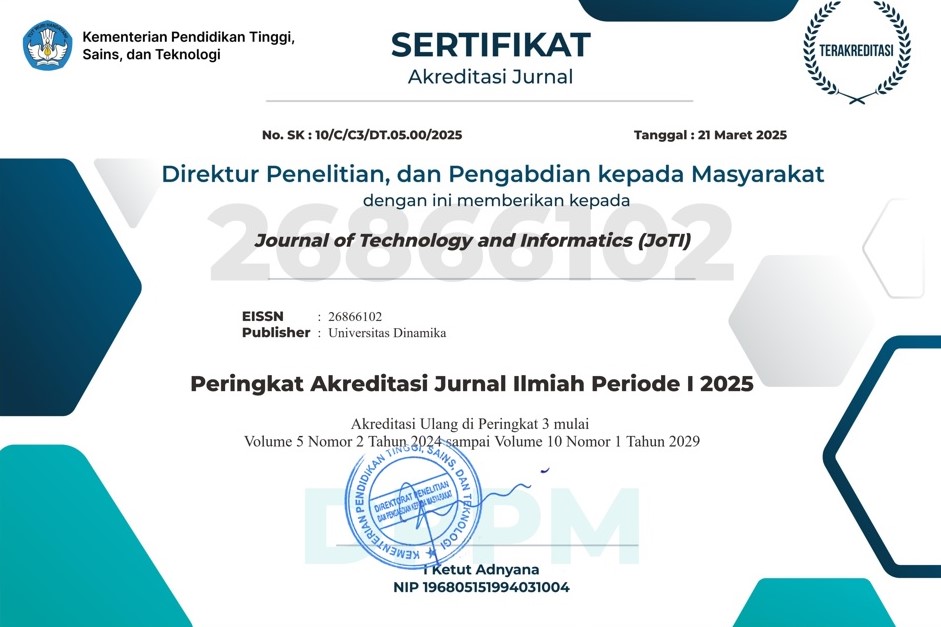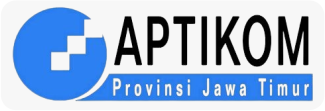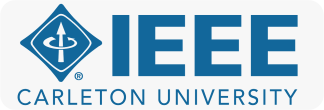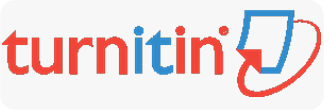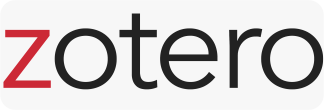Author Guidelines
MANUSCRIPT SUBMISSION INSTRUCTIONS
GENERAL REQUIREMENTS:
The submitted manuscript has never been published and is not in the process of evaluating other publications; it has obtained the approval of the co-author, if any, as the party who is equally responsible for the manuscript. The publisher will not be liable for claims or requests for compensation for matters relating to the manuscript. Manuscripts should be submitted via the submission menu in the Journal of Technology and Informatics (JoTI) at the address https://ejournals.dinamika.ac.id/index.php/joti/about/submissions. Manuscripts submitted must be typed on A4 paper, one-spaced with paper margin as follows: right 2 cm, left 2,49 cm, top 3 cm, and bottom 2 cm. Manuscript must not exceed 10 pages including table and figure. Please download the Ethics Statement and Copyright Agreement. Please sign and submit a Statement of Ethics as part of your initial article submission or during the submission phase. The Copyright Agreement must be submitted before the article can be published. The Statement of Ethics and Copyright Agreement can be uploade on the submission phase or sent by email (joti@dinamika.ac.id).
JOURNAL SCOPE:
This journal contains reviews of research results that have been published, associated with theory, valuation of other research results or policy provisions aimed at policymakers as material for decision-makers. Problems are discussed comprehensively, and strive to provide information about technology and information.
Submission Preparation
Language:
Articles are written in Indonesian and English (abstract and keywords). The use of the term follows the KBBI (The Great Indonesian Dictionary).
TYPES OF MANUSCRIPT:
Manuscripts are arranged in the following order: title of the article, author’s name, the origin of institution and email, abstract in Indonesian and English (250 words) and keywords (Indonesian and English), introduction, research method, conclusion, and suggestion, acknowledgment (if any) ends with a bibliography using the reference management tool (Mendeley).
ARTICLE TITLE:
The title should be short, factual, and informative, accurately reflecting the manuscript’s content. The title cannot be more than 16 words.
AUTHORS’ NAME:
The author’s name, the name of the institution where the author works, and his email are listed below the title. If there is more than one author, then the writing of his name follows the writing code of ethics.
ABSTRACT:
The abstract summarizes the most important elements of the manuscript. A maximum 200 word abstract in English in italics with Segoe UI 10 point. Abstract should be clear, descriptive, and should provide a brief overview of the problem studied. Abstract topics include reasons for the selection or the importance of research topics, research methods and a summary of the results. Abstract should end with a comment about the importance of the results or conclusions brief.
KEYWORDS:
A minimum of three to six keywords consisting of one word or a combination of words that indicate the main subjects in the manuscript and are written in alphabetical order.
INTRODUCTION:
The introduction consists of background, state of the art, gap research analysis and research objectives/problems. The state of the art is the research background, previous research, research objectives and questions. Gap research analysis is the reason why research needs to be carried out and the latest (unique) research. The research objectives/questions state the research problems to be solved in the research.
There is no space between paragraphs. Segoe UI font style 11pt, Normal, Space 1.0, all english or foreign terms are italicized.
METHOD
Describe how the research was conducted. The subject matter of this section is (1) research design or design, (2) procedures (can be algorithms, diagram blocks, pseudocode), (3) testing.
RESULTS AND DISCUSSION
Contains results and discussions that answer research questions. The results presented are 'net results'. The delivery of results can be presented in the form of tables, graphs or other forms of communication. Graphs and tables should be discussed within the body of the article.
If the presentation is long enough, it can be divided into several sub-sections. There is no space between paragraphs. The discussion must be compared with relevant research in accordance with the topic discussed and indicated by citations.
CONCLUSIONS AND SUGGESTIONS
Presenting the conclusions of the research discussed and answering the research problems. From these two things, new points of thought were developed which are the essence of the research findings. The content of the suggestion includes the limitations or subsequent development of the research. Conclusions and Suggestions are written in the form of paragraphs.
ACKNOWLEDGMENTS [OPTIONAL]
The author may add a Acknowledgment in a separate section, in particular to thank xxxx for providing financial support to this research.
REFERENCES [FONT 11 BOLD UPPERCASE]
The source of the citations and the bibliography of the manuscript should be the same and consistent. The bibliography writing format refers to The Institute of Electrical and Electronics Engineers (IEEE). Writing citations and bibliographies of manuscripts should use the Mendeley application. The number of scientific readings used as a bibliography is at least 10 titles (80% primary references and 20% secondary references). Primary references consist of journals, journals/articles, research reports, theses, theses, dissertations, patents, standards, and historical documents; while secondary references, include general books and scientific information sources on the internet. References referred to at least the last 10 years. 20% references are taken from JoTI journals.
UNITS OF MEASUREMENT:
Units of measurement in text and graphics use the metric system, for example, in units of microns, mm, cm, km, for length; cm3, liters for volume; and g, kg, tonnes by weight. Avoid using pikul units, quintals, and so on.
TABLE:
Tables should be given short but clear titles with sufficient notes, including table sources if the table refers to other references so that each table can explain the information presented independently. Each table is numbered sequentially and reviewed in the text.
FIGURES AND GRAPHICS:
Figures and graphs must be explained in an informative manner. As with the table, the information on the graph must be sufficient to be presented independently. Figures and graphics should be reviewed in the text. Black and white or color photos should be of good quality.
BIBLIOGRAPHY:
Bibliography compiled using the Mendeley software, Citation Style: IEEE, with a list of minimum 10 references. Primary literature from several authors is expected to be more numerous than secondary literature. The novelty of the library has been attempted for the last 10 years.
MANUSCRIPT SELECTION MECHANISM:
The editors make corrections and improvements and change the format according to the journal’s informative nature without changing the manuscript’s meaning. The editor will return the manuscript to the author to be corrected following the results of the editorial corrections and the rejected manuscripts with reasons according to the editorial board’s decision. The author is expected to immediately return the revision of the manuscript so that it can be published on time.

